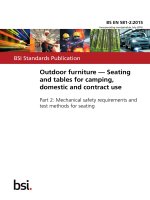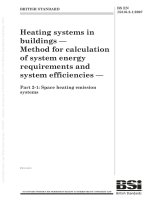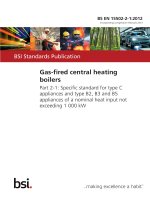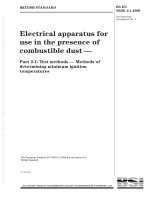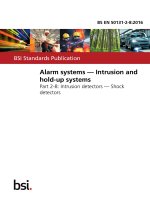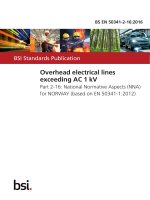Bsi bs en 16704 2 1 2016
Bạn đang xem bản rút gọn của tài liệu. Xem và tải ngay bản đầy đủ của tài liệu tại đây (3.35 MB, 34 trang )
BS EN 16704-2-1:2016
BSI Standards Publication
Railway applications — Track —
Safety protection on the track
during work
Part 2-1: Common solutions and
technologies — Technical requirements for
Track Warning Systems (TWS)
BS EN 16704-2-1:2016
BRITISH STANDARD
National foreword
This British Standard is the UK implementation of EN
16704-2-1:2016.
The UK participation in its preparation was entrusted to Technical
Committee RAE/2, Railway Applications - Track.
A list of organizations represented on this committee can be
obtained on request to its secretary.
This publication does not purport to include all the necessary
provisions of a contract. Users are responsible for its correct
application.
© The British Standards Institution 2016.
Published by BSI Standards Limited 2016
ISBN 978 0 580 85885 7
ICS 93.100
Compliance with a British Standard cannot confer immunity from
legal obligations.
This British Standard was published under the authority of the
Standards Policy and Strategy Committee on 30 November 2016.
Amendments/corrigenda issued since publication
Date
Text affected
BS EN 16704-2-1:2016
EN 16704-2-1
EUROPEAN STANDARD
NORME EUROPÉENNE
EUROPÄISCHE NORM
November 2016
ICS 93.100
English Version
Railway applications - Track - Safety protection on the
track during work - Part 2-1: Common solutions and
technologies - Technical requirements for Track Warning
Systems (TWS)
Applications ferroviaires - Voie - Protection et sécurité
durant des travaux sur la voie - Partie 2-1: Solutions
communes et technologie - Exigences relatives aux
dispositifs d'annonce des circulations (TWS)
Bahnanwendungen - Oberbau - Sicherungsmnahmen
während Gleisbauarbeiten - Teil 2-1: Allgemeine
Lưsungen und Technologien - Technische
Anforderungen an Warnsysteme an Gleisen (TWS)
This European Standard was approved by CEN on 6 August 2016.
CEN members are bound to comply with the CEN/CENELEC Internal Regulations which stipulate the conditions for giving this
European Standard the status of a national standard without any alteration. Up-to-date lists and bibliographical references
concerning such national standards may be obtained on application to the CEN-CENELEC Management Centre or to any CEN
member.
This European Standard exists in three official versions (English, French, German). A version in any other language made by
translation under the responsibility of a CEN member into its own language and notified to the CEN-CENELEC Management
Centre has the same status as the official versions.
CEN members are the national standards bodies of Austria, Belgium, Bulgaria, Croatia, Cyprus, Czech Republic, Denmark, Estonia,
Finland, Former Yugoslav Republic of Macedonia, France, Germany, Greece, Hungary, Iceland, Ireland, Italy, Latvia, Lithuania,
Luxembourg, Malta, Netherlands, Norway, Poland, Portugal, Romania, Slovakia, Slovenia, Spain, Sweden, Switzerland, Turkey and
United Kingdom.
EUROPEAN COMMITTEE FOR STANDARDIZATION
COMITÉ EUROPÉEN DE NORMALISATION
EUROPÄISCHES KOMITEE FÜR NORMUNG
CEN-CENELEC Management Centre: Avenue Marnix 17, B-1000 Brussels
© 2016 CEN
All rights of exploitation in any form and by any means reserved
worldwide for CEN national Members.
Ref. No. EN 16704-2-1:2016 E
BS EN 16704-2-1:2016
EN 16704-2-1:2016 (E)
Contents
Page
European foreword....................................................................................................................................................... 4
Introduction .................................................................................................................................................................... 5
1
Scope .................................................................................................................................................................... 6
2
Normative references .................................................................................................................................... 6
3
Terms and definitions ................................................................................................................................... 7
4
4.1
4.2
4.2.1
4.3
4.3.1
4.3.2
4.4
4.4.1
4.4.2
4.5
4.5.1
4.5.2
Functional requirements........................................................................................................................... 11
Types of TWS.................................................................................................................................................. 11
General functional requirements ........................................................................................................... 11
System definition ......................................................................................................................................... 11
LOWS ................................................................................................................................................................. 13
Lookout Operated Warning System (LOWS) ...................................................................................... 13
Lookout Operated Warning System with Influence Function (LOWS-I) .................................. 14
ATWS................................................................................................................................................................. 15
Automatic Track Warning System ATWS ............................................................................................ 15
Automatic Track Warning System with Influence Function (ATWS-I) ..................................... 16
SCWS ................................................................................................................................................................. 16
Signal Controlled Warning System (SCWS)......................................................................................... 16
Signal Controlled Warning System with Influence Function (SCWS-I) ..................................... 17
5
5.1
5.2
5.3
5.4
5.5
5.6
5.7
5.8
5.8.1
5.8.2
5.8.3
5.8.4
5.8.5
5.8.6
5.8.7
5.8.8
5.8.9
5.8.10
5.8.11
5.8.12
5.8.13
5.8.14
5.8.15
5.8.16
5.9
5.9.1
Non-functional requirements .................................................................................................................. 17
Communication ............................................................................................................................................. 17
Reliability ........................................................................................................................................................ 17
Availability ..................................................................................................................................................... 17
Maintainability .............................................................................................................................................. 17
Functional Safety .......................................................................................................................................... 17
Service Life...................................................................................................................................................... 17
Safety for the user ........................................................................................................................................ 18
Environment .................................................................................................................................................. 18
General ............................................................................................................................................................. 18
Protection against dust and water (IP-Codes) ................................................................................... 18
Pollution .......................................................................................................................................................... 18
Compatibility with Electromagnetic Current (EMC compatibility) ............................................ 18
Power Supply ................................................................................................................................................. 18
External connectors and cables .............................................................................................................. 18
Altitude ............................................................................................................................................................ 18
Pulse Pressure ............................................................................................................................................... 19
Temperature .................................................................................................................................................. 19
Humidity .......................................................................................................................................................... 19
Wind .................................................................................................................................................................. 19
Snow and hail................................................................................................................................................. 19
Ice ....................................................................................................................................................................... 19
Solar radiation .............................................................................................................................................. 19
Lightning protection ................................................................................................................................... 19
Fire protection .............................................................................................................................................. 19
Vibration and Shock .................................................................................................................................... 20
General ............................................................................................................................................................. 20
2
BS EN 16704-2-1:2016
EN 16704-2-1:2016 (E)
5.9.2
5.9.3
5.10
5.11
5.12
5.13
5.14
5.15
5.16
5.17
5.18
5.18.1
5.18.2
5.19
5.19.1
5.19.2
5.19.3
5.20
5.21
5.22
5.23
Vibration .......................................................................................................................................................... 20
Shock ................................................................................................................................................................. 20
Dimension, mass, handling ....................................................................................................................... 20
Control elements of the TWS .................................................................................................................... 20
Indication on the TWS ................................................................................................................................. 21
Technical processing time ......................................................................................................................... 21
TWS power supply and power consumption ...................................................................................... 22
Warning in case of a safety critical failure .......................................................................................... 22
Technical detection ...................................................................................................................................... 22
Speed Range for detection components ............................................................................................... 22
TWS-Signal ...................................................................................................................................................... 22
Acoustic TWS-Signal .................................................................................................................................... 22
Optical TWS-Signals ..................................................................................................................................... 23
Information by Human-Machine-Interface (HMI) ............................................................................ 23
During operation .......................................................................................................................................... 23
Priority of information on the HMI ........................................................................................................ 23
Developing HMI ............................................................................................................................................. 23
Data logging .................................................................................................................................................... 23
User manual .................................................................................................................................................... 24
Marking ............................................................................................................................................................ 24
Colour ................................................................................................................................................................ 25
Annex A (normative) Specification of acoustic warning signals............................................................... 26
A.1
General ............................................................................................................................................................. 26
A.2
Sound criteria for acoustic TWS-Signals .............................................................................................. 26
A.3
Time criteria for acoustic TWS-Signals................................................................................................. 27
Annex B (normative) Specification of optical TWS signals ......................................................................... 28
B.1
General ............................................................................................................................................................. 28
Bibliography ................................................................................................................................................................. 29
3
BS EN 16704-2-1:2016
EN 16704-2-1:2016 (E)
European foreword
This document (EN 16704-2-1:2016) has been prepared by Technical Committee CEN/TC 256 “Railway
applications”, the secretariat of which is held by DIN.
This European Standard shall be given the status of a national standard, either by publication of an
identical text or by endorsement, at the latest by May 2017, and conflicting national standards shall be
withdrawn at the latest by May 2017.
Attention is drawn to the possibility that some of the elements of this document may be the subject of
patent rights. CEN not be held responsible for identifying any or all such patent rights.
This document has been prepared under a mandate given to CEN by the European Commission and the
European Free Trade Association.
This European Standard is one of the series EN 16704 “Railway applications – Track – Safety protection
on the track during work” as listed below:
— Part 1: Railway risks and common principles for protection of fixed and mobile work sites
— Part 2-1: Common solutions and technology – Technical requirements for Track Warning Systems
(TWS)
— Part 2-2: Common solutions and technology – Technical requirements for barriers
— Part 3: Competences of personnel related to work on or near the railway track
According to the CEN-CENELEC Internal Regulations, the national standards organisations of the
following countries are bound to implement this European Standard: Austria, Belgium, Bulgaria,
Croatia, Cyprus, Czech Republic, Denmark, Estonia, Finland, Former Yugoslav Republic of Macedonia,
France, Germany, Greece, Hungary, Iceland, Ireland, Italy, Latvia, Lithuania, Luxembourg, Malta,
Netherlands, Norway, Poland, Portugal, Romania, Slovakia, Slovenia, Spain, Sweden, Switzerland,
Turkey and the United Kingdom.
4
BS EN 16704-2-1:2016
EN 16704-2-1:2016 (E)
Introduction
The purpose of this standard is to define the requirements for Track Warning Systems (TWS) used to
warn people about approaching trains and rail vehicles when on or near the track during their work.
TWS can be subdivided into the following types:
— LOWS – Lookout Operated Warning Systems;
— ATWS – Automatic Track Warning Systems;
— SCWS – Signal Controlled Warning Systems.
Each class can be used as a warning system by itself or with an additional function that can influence
approaching trains and rail vehicles. For instance LOWS-I, ATWS-I or SCWS-I (-I: influence function).
This standard defines minimum system requirements for TWS.
5
BS EN 16704-2-1:2016
EN 16704-2-1:2016 (E)
1 Scope
This European Standard defines minimum functional and non-functional requirements for Track
Warning Systems (TWS) used to warn persons about approaching trains and rail vehicles during their
work on or near the track. These systems may also have an additional function that can influence the
approaching trains and rail vehicles. The influence could be a stopping, passing or other function.
This European Standard is applicable to:
— systems, sub-systems and components within TWS, including those containing software;
— new TWS;
— new integrations of systems, sub-systems and components into existing TWS; and
— modifications of TWS developed according to this standard.
It is also recommended to use this standard for single warning units (e.g. simple electrical horns).
This European Standard does not apply to the following items:
— hazards during the installation/removal of the TWS caused by trains and rail vehicles on the lines;
— hazards caused by the improper use of TWS;
— hazards caused by the improper behaviour of persons working on or near the track;
— hazards caused by the (unauthorized) presence of persons on or near the track;
— CO2-horns (tyfons), human operated pressure signal horns, flags, detonators or machine warning
systems according to UIC 644;
— national safety regulations to plan and operate TWS in track.
2 Normative references
The following documents, in whole or in part, are normatively referenced in this document and are
indispensable for its application. For dated references, only the edition cited applies. For undated
references, the latest edition of the referenced document (including any amendments) applies.
EN 894-3:2000+A1:2008, Safety of machinery - Ergonomics requirements for the design of displays and
control actuators - Part 3: Control actuators
EN 16704-1:2016, Railway applications – Track – Safety protection on the track during work – Part 1:
Railway risks and common principles for protection of fixed and mobile work sites
EN 50121-4, Railway applications – Electromagnetic compatibility – Part 4: Emission and immunity of the
signalling and telecommunications apparatus
EN 50125-3:2003, Railway applications - Environmental conditions for equipment - Part 3: Equipment for
signalling and telecommunications
EN 50126-1:1999, Railway applications - The specification and demonstration of Reliability, Availability,
Maintainability and Safety (RAMS) - Part 1: Basic requirements and generic process
6
BS EN 16704-2-1:2016
EN 16704-2-1:2016 (E)
EN 50128, Railway applications – Communications, signalling and processing systems – Software for
railway control and protection systems
EN 50129, Railway applications - Communication, signalling and processing systems - Safety related
electronic systems for signalling
EN 50159, Railway applications - Communication, signalling and processing systems - Safety-related
communication in transmission systems
EN 60204-1, Safety of machinery - Electrical equipment of machines - Part 1: General requirements
EN 60529, Degrees of protection provided by enclosures (IP Code)
EN 61310-1, Safety of machinery - Indication, marking and actuation - Part 1: Requirements for visual,
acoustic and tactile signals
EN ISO 12100, Safety of machinery - General principles for design - Risk assessment and risk reduction
(ISO 12100)
3 Terms and definitions
For the purposes of this document, the terms and definitions given in EN 16704-1:2016 and the
following apply.
Figure 1 — Overview TWS family
3.1
Track Warning System
TWS
system which warns people of approaching trains and rail vehicles when they are on or near the track.
These systems may also be able to influence the approaching trains and rail vehicles. The influence
could be a stopping, passing or other function
7
BS EN 16704-2-1:2016
EN 16704-2-1:2016 (E)
3.2
human activated system
TWS where the process for detecting approaching trains and rail vehicles is dependent on human
interaction
3.3
technical activated system
TWS where the process for detecting approaching trains and rail vehicles is independent of human
interaction
3.4
Lookout Operated Warning System
LOWS
TWS which detects approaching trains and rail vehicles by human operated detection units including a
vigilance control for human operated detection units
3.5
Automatic Track Warning System
ATWS
TWS which detects approaching trains and rail vehicles by technical means (e.g. treadles, axle counters)
3.6
Signal Controlled Warning System
SCWS
TWS which detects approaching trains and rail vehicles by data from the signalling system
3.7
TWS-input
step or steps in the process of a TWS which detect approaching and/or leaving trains and rail vehicles
3.8
TWS-communications
step or steps in the process of a TWS which provide communications between TWS functional units
(these can be wired and/or wireless) according to EN 50159
3.9
TWS-logic
step or steps in the process of a TWS to process the input and to generate warning information for the
output
3.10
TWS-output
step or steps in the process of a TWS
a) to warn people by TWS-Signals and/or
b) to influence approaching trains and rail vehicles
3.11
TWS-Signals
acoustic and/or optical signals to warn people on or near the track about approaching trains and rail
vehicles
3.12
human detection
detection activated by a person (e.g. lookout) as input for TWS
8
BS EN 16704-2-1:2016
EN 16704-2-1:2016 (E)
3.13
human activation
activation of a TWS-signal by a person (e.g. lookout, TWS-Operator)
3.14
human cancellation
cancellation of a TWS-Signal by a person (e.g. lookout, TWS-Operator) as input for TWS
3.15
technical detection
detection activated by an approaching train or rail vehicle not operated by a person (e.g. treadles, axle
counters) as input for TWS
3.16
technical cancellation
cancellation of a TWS-Signal not by a person (e.g. treadles, axle counters) as input for TWS
3.17
safety critical failure
failure according to EN 50129, which could affect the safety integrity of the system
3.18
failure
deviation from the specified performance of a system. A failure is the consequence of a fault or error in
the system
[SOURCE: EN 50129:2003, definition 3.1.17]
3.19
failsafe
concept which is incorporated into the design of a product such that, in event of a failure, it enters or
remains in safe state
[SOURCE: EN 50129:2003, definition 3.1.16]
3.20
Safety Integrity Level
SIL
number which indicates the required degree of confidence that a system will meet its specified safety
functions with respect to systematic failures
[SOURCE: EN 50129:2003, definition3.1.51]
3.21
RAMS (Reliability, Availability, Maintainability, and Safety)
acronym meaning a combination of reliability, availability, maintainability and safety
[SOURCE: EN 50126-1:1999, definition 3.29]
3.21.1
reliability
probability that an item can perform a required function under given conditions for a given time
interval
9
BS EN 16704-2-1:2016
EN 16704-2-1:2016 (E)
[SOURCE: EN 50126-1:1999, definition 3.30]
3.21.2
availability
ability of a product to be in a state to perform a required function under given conditions at a given
instant of time or over a given time interval assuming that the required external resources are provided
[SOURCE: EN 50126-1:1999, definition 3.4]
3.21.3
maintainability
probability that a given active maintenance action, for an item under given conditions of use, can be
carried out within a stated time interval when the maintenance is performed under stated conditions
and using stated procedures and resources
[SOURCE: EN 50126-1:1999, definition 3.20]
3.21.4
safety
freedom from unacceptable level of risk
[SOURCE: EN 50126-1:1999, definition 3.35]
3.22
safety relevant information of TWS
safety relevant operational information recorded and stored in a data recorder
3.23
data recorder/black box
location/locations in the TWS where safety relevant information is stored and can be accessed
3.24
safe state
condition which continues to preserve safety
[SOURCE: EN 50129:2003, definition 3.1.44]
3.25
TWS-Operator
person who operates TWS
3.26
influence function
function of a TWS to influence approaching trains and rail vehicles
3.27
vigilance control
technical function to control the vigilance of a person (e.g. dead-man’s button)
3.28
announcement time
period between the moment the warning starts and the moment the approaching train or rail vehicle
reaches the beginning of the work site
10
BS EN 16704-2-1:2016
EN 16704-2-1:2016 (E)
3.29
technical processing time
maximum time period for technically processing the steps from Input to Output, including technical
latency and technical communication
Note 1 to entry: The technical processing time does not include time for human reaction, time for the vigilance
function, clearance time and safety margin time (see EN 16704–1:2016).
3.30
warning area
area on or near the track where people are warned by TWS
3.31
interlocking
interdependent liaison between the control levers or the electrical control circuits of different
apparatus such as points, signals, which makes it impossible to place them in positions which are unsafe
Note 1 to entry:
In English, the term “interlocking” refers also to the place where interlocking is achieved.
Note 2 to entry: In French, the term “enclenchement” refers also to the individual locking of an apparatus such
as a pair of points.
[SOURCE: IEC 60050-821:1998, 821-05-02]
3.32
rail vehicle
machine designed and intended to operate signalling and control systems
Note 1 to entry:
Rail vehicles meet the standards for machines in running mode.
4 Functional requirements
4.1 Types of TWS
TWS are LOWS, ATWS and SCWS with the same purpose (see 4.2.1). There is modularity in TWS
assigned to the method/kind of input of the TWS.
4.2 General functional requirements
4.2.1 System definition
4.2.1.1 General
The safety function of a TWS (LOWS, ATWS, SCWS) is: TWS shall warn people on or near the track
against approaching trains and rail vehicles.
NOTE
For TWS-I additional safety functions will be specified in a later version of this European Standard.
TWS shall have the functional components input, logic and communication and output (Figure 2).
TWS-Operators interact with the TWS by Human Machine Interface (HMI) (e.g. human detection of
trains, activate a warning signal or cancelling a warning signal).
11
BS EN 16704-2-1:2016
EN 16704-2-1:2016 (E)
Figure 2 — TWS and the mutual relationship of the process steps
4.2.1.2 Developing of TWS
TWS shall be developed according to EN 50126-1, EN 50128 and EN 50129.
4.2.1.3 Failsafe
TWS shall work failsafe according to 5.5.
4.2.1.4 Indication of operation state
TWS shall have a function to indicate safe operation state.
4.2.1.5 Train detection and cancellation
Train detection and cancellation can be done by technical and/or human intervention.
Technical train detection shall be possible for both directions on each track.
4.2.1.6 HMI (Human-Machine-Interface)
For the interaction between the TWS and the TWS-operator there shall be a HMI.
4.2.1.7 Security
Safety relevant operational settings (e.g. via software or hardware button, switches) shall be protected
against unauthorized operation.
4.2.1.8 Data logging
It shall be possible, to make the relevant data available.
12
BS EN 16704-2-1:2016
EN 16704-2-1:2016 (E)
4.2.1.9 TWS open output
The TWS shall transmit redundant information on the safe state of the TWS and on the warning status
to an open output.
The TWS should also transmit redundant information on the safe state of the work-site to an open
output.
4.2.1.10 Influencing of a train or rail vehicles
TWS-I shall be able to influence trains and rail vehicles.
NOTE
Will be specified in a later version of this standard.
4.2.1.11 Infrastructure compatibility
The TWS shall not influence the railway infrastructure unintentionally. The TWS shall not be influenced
by the railway infrastructure unintentionally.
4.2.1.12 User safety
The electrical and mechanical construction of TWS shall not cause any hazards during operation,
handling, (including transport, installation and removal) and maintenance.
4.2.1.13 Training of the staff
The manufacturer shall provide recommendations for training to ensure safe operation of the TWS
including servicing and minor repairs.
4.3 LOWS
4.3.1 Lookout Operated Warning System (LOWS)
Figure 3 — LOWS and the functional parts
LOWS is a TWS which detects approaching trains and rail vehicles by human operated detection units
including a vigilance control for human operated detection units.
13
BS EN 16704-2-1:2016
EN 16704-2-1:2016 (E)
LOWS consists of the following functional parts:
a) LOWS input: Train Detection (Input);
b) LOWS Control Unit (Logic and Communication);
c) LOWS output: Warning Unit (Output).
The functional parts can be combined in one device or the functional parts can be separate devices.
The functional part a) receives information that a trains or rail vehicle is approaching following human
activation of an input device. The functional part a) generates a message that is transmitted to the
functional part b) technically, without further human interaction.
The functional part a) shall have a vigilance function. In the event that the lookout fails to maintain
vigilance, the LOWS shall give the TWS-Signal.
NOTE
LOWS rely on human detection of approaching trains and rail vehicles.
The functional part b) processes the message and generates a warning message, which in turn is
technically transmitted to functional Part c) without further human interaction.
The functional part b) shall be able to process the transmitted information about all detected trains and
rail vehicles, which shall be sent by functional part a).
The functional part b) shall be able to transmit the Warning message to more than one functional part
c).
It shall be possible to activate a TWS-Signal at the functional part b) by human intervention. A vigilance
control is not mandatory for this requirement.
The cancellation of the TWS-Signal shall be done by technical or human intervention. A technical
cancellation message shall be generated and transmitted to functional part b).
The functional part c) shall generate the technical TWS-Signals (see Annex A and Annex B).
It shall be possible to adapt the announcement time to meet the individual requirements of the work
site (e.g. individual planning of the warning area, individual planning of the location of functional part
a)).
4.3.2 Lookout Operated Warning System with Influence Function (LOWS-I)
LOWS-I is a LOWS equipped with the possibility to influence approaching trains and rail vehicles.
NOTE
14
Will be specified in a later version of this European Standard.
BS EN 16704-2-1:2016
EN 16704-2-1:2016 (E)
4.4 ATWS
4.4.1 Automatic Track Warning System ATWS
Figure 4 — ATWS and the functional parts
ATWS is a TWS which detects approaching trains and rail vehicles by technical means (e.g. treadles, axle
counters).
ATWS shall consist of the following functional parts:
a) ATWS Input: Train Detection (Input);
b) ATWS Control Unit (logic and communication);
c) ATWS Output: Warning Unit (Output).
The functional parts can be combined in one device or the functional parts can be separate devices.
The functional part a) generates a message following the input that an approaching train or rail vehicle
has been detected by technical means. This message shall be technically transmitted to functional part
b), without human interaction.
The functional part b) processes all messages and generates a warning message, which in turn is
technically transmitted to functional part c), without human interaction.
The functional part b) shall be able to transmit the Warning message to more than one functional part
c).
It shall be possible to activate a TWS-Signal at the functional part b) by human intervention. A vigilance
control is not mandatory for this requirement. The cancellation of the TWS-Signal shall be done by
technical or human intervention. A technical cancellation message shall be generated and transmitted
to functional part b).
The functional part c) shall technically generate the TWS-Signal (see Annex A and Annex B).
It shall be possible to adapt the announcement time to meet the individual requirements of the work
site (e.g. individual planning of the warning area, individual planning of the location of the Train
Detection units).
15
BS EN 16704-2-1:2016
EN 16704-2-1:2016 (E)
4.4.2 Automatic Track Warning System with Influence Function (ATWS-I)
ATWS-I is an ATWS equipped with the possibility to influence approaching trains and rail vehicles.
NOTE
Will be specified in a later version of this European Standard.
4.5 SCWS
4.5.1 Signal Controlled Warning System (SCWS)
Figure 5 — SCWS and basic functional parts
SCWS is a TWS which is connected to the signalling system. SCWS processes the information about
approaching trains and rail vehicles from the signalling system.
A basic SCWS consists as a minimum of the following functional parts:
a) SCWS Input: Train position information;
b) SCWS Logic and Communication: Process;
c) SCWS Output: Warning signal.
The functional part a) receives information about the position of trains and rail vehicles from various
sources such as the signal interlocking or signal control or traffic management system. This technical
information is received directly from the source system without human interaction.
The functional part b) will hold relevant data for the configuration of the warning area/s. This
configuration data will be prepared for the specific needs of each warning area e.g. announcement time,
line speed and direction of travel.
The functional part b) processes the train position information and generates a warning message when
any train or rail vehicle reaches a predetermined trigger point on approach to a predetermined warning
area.
The functional part b) transmits the generated warning message to functional Part c) through technical
means, without human interaction.
16
BS EN 16704-2-1:2016
EN 16704-2-1:2016 (E)
The functional part c) receives the warning message, generates and emits TWS-Signals.
The TWS-Signals is cancelled automatically by a cancellation message generated and transmitted by
functional Part b) and received by functional part c).
Human cancellation of the TWS-Signal is a possible option.
4.5.2 Signal Controlled Warning System with Influence Function (SCWS-I)
SCWS-I is a SCWS equipped with the possibility to influence approaching trains and rail vehicles.
NOTE
Will be specified in a later version of this European Standard.
5 Non-functional requirements
5.1 Communication
Functional parts of TWS shall communicate according to EN 50159.
5.2 Reliability
The MTBF according to EN 50126-1 for the complete system should not be less than 5 000 operating
hours.
NOTE
MTBF means Mean Time Between Failure.
5.3 Availability
The method of calculating the availability shall be based on a theoretical permanent installation of a
TWS site. It shall be specified according to EN 50126-1 by the manufacturer and shall be part of the
product information provided for users.
A
=
∑t
∑t
available
available
+ ∑tunavailable
×100 %
5.4 Maintainability
Information on maintenance, services and life cycle shall be part of the product documentation.
5.5 Functional Safety
LOWS and ATWS shall be developed according to EN 50126-1, EN 50128 and assessed according to
EN 50129 for Safety Integrity Level 3 or better and a quantitative THR of 1,14 × 10−8 per hour or better.
SCWS shall be developed according EN 50126-1, EN 50128 and EN 50129 for Safety Integrity Level 1 or
better. The required SIL level and THR has to be given by the railway infrastructure manager.
NOTE
For the interface of a TWS interlocked to the Signalling System the SIL level and THR is given by the
railway infrastructure manager. THR of 1,14 × 10−8 is taken from ERRI Report A158 3 Part 1 (see bibliography no
[3]). THR is the abbreviation for Tolerable Hazard Rate.
5.6 Service Life
TWS shall have a service life of at least ten years. The supply of spare parts shall be guaranteed during
the aforementioned service life period.
17
BS EN 16704-2-1:2016
EN 16704-2-1:2016 (E)
5.7 Safety for the user
TWS shall be developed for safe use and operation according to EN ISO 12100. For electrical safety see
EN 60204-1, for electrical creepage and clearance EN 50124-1.
5.8 Environment
5.8.1 General
TWS shall be designed for safe functioning in all environments that it is to be used, according to
EN 50125-3 and EN 50121-4.
NOTE
For specification for other climate see standard of series EN 60721–3 and for testing see standard of
series IEC/TR 60721–4.
5.8.2 Protection against dust and water (IP-Codes)
TWS components and sub-systems shall apply protection against dust and water (IP-Codes) according
to EN 60529.
— outdoor use: IP 65
— indoor use: IP 20
5.8.3 Pollution
The effects of pollution shall be considered in the design of equipment and components according to
EN 50125-3.
5.8.4 Compatibility with Electromagnetic Current (EMC compatibility)
TWS shall apply the requirements in accordance with standard of series EN 50121.
5.8.5 Power Supply
TWS should be able to use mains power supply of a range of 110 V AC to 240 V AC.
NOTE
It is recommended to reach class 3 of Table 1 of EN 61000–2–4:2002.
5.8.6 External connectors and cables
Cables and connectors shall be non-halogenated. Connectors should have a pull relief and locking
system.
The cable link may consist of several cable units. One cable unit consists of a cable of fixed length, a
carrier device and connectors at each end of the cable. It should be possible to bend the cable to a radius
of 50 mm or less. The cable should not be damaged by tensile loads of less than 500 N. It should be
possible to bolt the connectors together. Each connector should be fitted with a built-in removable
protective cap. The cable connectors should guarantee at least 5 000 connection and disconnection
operations.
5.8.7 Altitude
TWS shall work at an altitude according EN 50125-3:2003, class A1.
18
BS EN 16704-2-1:2016
EN 16704-2-1:2016 (E)
5.8.8 Pulse Pressure
TWS should continue to work with a change or fluctuation of air pressure (e.g. passing trains) in
accordance with EN 50125-3.
NOTE
Clause 6.
Due to missing test procedures in EN 50125–3 this item is not part of the assessment required in
5.8.9 Temperature
TWS shall work at a temperature range of class T1 according to EN 50125-3:2003.
NOTE
For testing see also EN 60068–2–1 and EN 60068–2–2.
5.8.10 Humidity
Sub-systems of TWS shall work in the complete air temperature range of subclause 5.8.8 at a humidity
level of class T1 according to EN 50125-3:2003.
NOTE
5.8.11
For testing see also EN 60068–2–56.
Wind
Equipment exposed to air movement shall be designed to withstand the stress generated according to
EN 50125-3.
NOTE
5.8.12
For more information see also EN 14067–4, EN 14067–5 and EN 14067–6.
Snow and hail
Consideration shall be given to the effect of snow and/or hail.
5.8.13
Ice
Equipment exposed to the effects of ice forming or falling shall be designed to operate in that
environment according to EN 50125-3.
5.8.14
Solar radiation
Equipment exposed to the effects of solar radiation shall be designed to ensure that it continues to
operate and comply with the parameters of the design specifications according to EN 50125-3.
NOTE
5.8.15
For testing see also EN 60068–2–5.
Lightning protection
Consideration shall be given to the effects of lightning on the equipment according to EN 50125-3.
NOTE
5.8.16
For testing see also EN 61000–4–5.
Fire protection
The level of fire protection should be stated in the relevant product information. The materials of the
systems shall be non-flammable or self-extinguishing and in this case shall not release corrosive smoke.
19
BS EN 16704-2-1:2016
EN 16704-2-1:2016 (E)
5.9 Vibration and Shock
5.9.1 General
TWS sub-systems shall be tested against random vibration and shock according to their position in
track.
During and directly after the tests against vibration and shock the system shall be and stay in the “ONmode” and should maintain safe and reliable operation. Signs of deterioration are allowed as long as the
safe and reliable functionality is not affected.
NOTE
For testing see also EN 60068–2–6.
5.9.2 Vibration
For the random tests of vibrations see Table 5 of EN 50125-3:2003. For vibrations, 30 min tests must be
carried out on each axis.
NOTE 1
NOTE 2
For use of equipment on a vehicle or machine see also EN 50125–1 and EN 50155.
For testing see also EN 60068–2–64.
5.9.3 Shock
For testing against shock see EN 50125-3:2003, Table 6. For the shock tests 3 shocks per direction shall
be carried out.
NOTE
For testing see also EN 60068–27.
5.10 Dimension, mass, handling
Portable TWS and its components should be designed for transportation, mounting and operation by
one person.
Components of a mass of more than 20 kg should be designed demountable in components of less than
20 kg. If this is not possible, parts of more than 20 kg shall be equipped with handles for transport and
use. Handles shall be in accordance with EN 894-3:2000+A1:2008, 8.1 (length > 100 mm, diameter
15 mm to 35 mm), they shall be easily accessible and near to the balance point. The handles are to be
positioned to ensure the sharing of the mass equally. The mass on each handle shall not exceed 20 kg. If
more than one person is recommended for transportation, mounting and operation the number of
people necessary shall be indicated on the component.
5.11 Control elements of the TWS
TWS shall be constructed for safe use and operation. Control elements should be designed according to
EN 894-3. Control elements shall be distinctive, clearly and durably marked and except for control
elements for the TWS emergency signal they shall be protected against accidental activation.
TWS shall be constructed such that operational settings are secured and can only be changed by
authorized persons via software or hardware.
TWS shall have at least the following control elements or capabilities (available via software or
hardware, e.g. on a HMI):
— On/Off-Switch;
— setting of TWS;
— activating the TWS-Signals (Wa 1, Wa 2 (see Annex A.3));
20
BS EN 16704-2-1:2016
EN 16704-2-1:2016 (E)
— activating of the emergency signal (Wa3 (see Annex A.3)) preferably by a pushbutton;
— cancellation of the TWS-Signals.
Control elements for vigilance (dead man’s button) and human activating of warning signals (including
influence function), shall be designed for operation with protective gloves.
5.12 Indication on the TWS
TWS shall indicate the following information using indicators or a display (on change or on demand):
— operation status;
— type of safety critical failure and failure;
— current TWS warning status.
TWS should indicate the following information using indicators or a display:
— TWS signals setting (Wa1, Wa2; acoustic and/or optical);
— influence function (only for TWS-I);
— next maintenance and service;
— quality of radio transmission.
Safety relevant information shall be indicated visually and acoustically preferably on a control unit of
the TWS.
The display / indication shall be low-reflective and easily readable by day and night.
The colour used for information shall comply with the standardized colour-codes of EN 61310-1.
TWS shall give an acoustic signal for a TWS-Operator preferable on a control unit concerning:
— indication of change of current TWS warning status;
— indication of a safety critical failure and failure;
— indication “influence function” (only TWS-I).
5.13 Technical processing time
TWS shall not exceed a technical processing time of more than 5 s before a TWS-Signal is given in all
cases including:
— technical and human detection of approaching of trains or rail vehicles;
— provision of train position information via signalling input to the TWS;
— detection of activation of the emergency pushbutton;
— identification of a safety critical failure;
— activation of a warning message from any vigilance control system.
21
BS EN 16704-2-1:2016
EN 16704-2-1:2016 (E)
5.14 TWS power supply and power consumption
The manufacturer shall state the power consumption of the system for the following parameters:
— at least 15 acoustic TWS-Signals at maximum sound pressure level within one hour;
— during each acoustic TWS-Signal, an optical TWS-Signal shall be displayed and continued 1 min
after the extinction of the acoustic TWS-Signal.
The manufacturer shall state the capacity of the batteries used in the system.
In the event of a safety critical failure of the power supply the TWS shall continue to operate safely or
fail-safe.
5.15 Warning in case of a safety critical failure
In case of any safety critical failure the regular acoustic TWS-Signal (Wa1, Wa2) shall be given by all
available warning units and the optical TWS-Signal by all available optic warning units for at least
30 min.
Information of the changed operational status and kind of failure shall be indicated on the TWS.
NOTE
The minimum time of 30 min is required to give the responsible person the time to inform all staff
within an extended work-site.
5.16 Technical detection
Technical detection shall detect the direction of passing trains and rail vehicles on the front side leading
edge of the train (e.g. on the first axle).
5.17 Speed Range for detection components
Detectors shall detect passing trains and rail vehicles from 3 km/h up to at least 180 km/h.
NOTE
This includes a safety margin for lines with a speed limit of 160 km/h
Technical detection shall not be compromised by trains or rail vehicles running at the maximum speed
given by the railway infrastructure manager.
5.18 TWS-Signal
5.18.1
Acoustic TWS-Signal
Acoustic TWS-Signals shall comply with Annex A (normative) of this standard.
Units for acoustic TWS-Signals shall reach a sufficient sound pressure level to guarantee the audibility
of the warning signal (at the ear of the worker: at least +3 dB) above the maximum sound pressure level
of the ambient noise. The sound pressure level of each unit should be adapted automatically to the
ambient noise of the work site (ALADIN – Automatic Level Adaption Due to Identified Noise) in a range
of at least 30 dB either continuously or in steps of max. 6 dB. Peaks of the noise with a duration of less
than 1 s should have no effect on this adaption.
The operational limitations of the TWS have to be part of the manufacturer's manual, i.e.:
— maximum distance of warning units;
— maximum permitted sound pressure level of the noise (as a function of distances of the warning
units).
22
BS EN 16704-2-1:2016
EN 16704-2-1:2016 (E)
According to EN ISO 7731 the A-weighted sound-pressure level of the TWS-Signal shall not be lower
than 65 dB at any position in the warning area to ensure the audibility.
NOTE
5.18.2
Acoustic planning of a work site is part of EN 16704–1:2016, A.3.5.
Optical TWS-Signals
Optical TWS-Signals shall comply with Annex B (normative) of this standard.
The colour of the optical signal of TWS shall be in accordance with the requirements of the national and
operational rules.
5.19 Information by Human-Machine-Interface (HMI)
5.19.1
During operation
An HMI shall display the following information without any interaction of the TWS-Operator:
— state of operation (in operation, out of operation, safety critical failure);
— warning (no warning (train), one warning (train), more than one warning (train));
— status of power supply.
On request of the TWS-Operator the HMI shall display additional information on the type of the safety
critical failure or failure.
5.19.2 Priority of information on the HMI
Safety critical failures shall be displayed on the HMI. Non safety critical failures shall be displayed on
the HMI subordinated to safety critical failure. Safety critical failures and non-safety critical failures
displayed on the HMI shall not be masked by any other information without intentional interaction of
the TWS-Operator.
5.19.3
Developing HMI
HMI should be developed with ergonomic considerations.
5.20 Data logging
TWS shall store relevant data in a secure data recorder / black box with timestamp (year, month, day,
hour, minute, second) for at least 168 h of operation. The data shall be accessible and readable without
interaction from the manufacturer.
This relevant data includes:
— status;
— operational settings;
— detection;
— status warning information;
— status power supplies;
— safety critical failures, non-safety critical failures.
23
